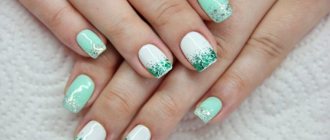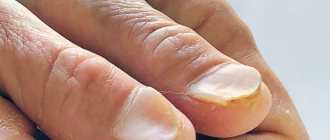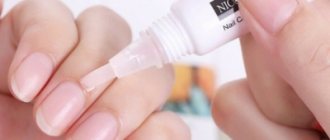Koilonychia is a type of nail dystrophy in which they become thinner, acquire a concave spoon-shaped shape, but retain a healthy pink color and smooth surface. Prevalence does not depend on gender or age. Koilonychia often speaks of other internal diseases in the body. Occurs in adults, children, newborns. To get rid of concave nails, you need to eliminate the cause of the deformation.
What types are there?
Depending on the severity of the course, two stages are distinguished:
- Early or initial, when thinning and flattening of the nail plate are noted. A small depression appears in the center, color and smoothness are preserved;
- Late, in which the subungual space changes, the nail becomes fragile, the free edge of the plate bends upward. The nail plate crumbles at the edges, but retains its natural color and smooth surface.
Depending on the cause, koilonychia can be:
- Hereditary or congenital, develops as a result of gene mutations. Dystrophy is inherited; many family members have it;
- Acquired, formed during life under the influence of external factors or internal diseases;
- Idiopathic, when the causes cannot be determined.
Causes of koilonychia
The mechanism of formation of spoon-shaped nails has not been studied enough, so it is difficult to unambiguously explain the origin of koilonychia. It is known that it is a symptom of other diseases; it can be caused by various reasons.
In the acquired form, the basis of the pathology is a violation of keratinization or deposition of keratin in the nails, which causes a deterioration in protein metabolism and tissue nutrition. Such changes occur under the influence of internal or external factors. As a result, the nail, which normally consists of several layers of keratinized skin cells, becomes single-layered, thin, and easily deformed.
External factors
External causes leading to koilonychia include:
- nail plate injuries;
- contact with harmful chemicals, petroleum products;
- frequent intense exposure to ultraviolet radiation;
- sudden changes in temperature;
- fungal infection (onychomycosis).
Koilonychia is often provoked by working with detergents and cleaning products without protective gloves, continuously wearing artificial nails, and constantly using acetone remover to remove nail polish.
There are high risks of developing the disease in people living at an altitude of more than 3000 m above sea level. This is explained by a decrease in blood oxygen saturation and its supply to organs and tissues. When oxygen levels are low, the production of erythrocytes (red blood cells) increases, which increases iron consumption, leading to iron deficiency.
Koilonychia is often observed in people of certain professions. For example, in people working with mineral oils and organic solvents, which provoke contact dermatitis. And also in people who are subject to constant injury or experience stress in their fingers. The disease occurs among hairdressers who work with ammonium thioglycolate for perming hair.
Internal factors
Among the internal factors, spoon-shaped deformation of the nail plate is caused by:
- Iron-deficiency anemia;
- endocrine disorders;
- psoriasis, lichen planus, systemic lupus erythematosus;
- lack of metalloenzymes and sulfur-containing amino acids in the body;
- changes in the nail matrix caused by decreased blood flow due to Raynaud's syndrome and vascular pathologies;
- endocrine pathologies (diabetes mellitus, hypothyroidism, hyperthyroidism).
- chemotherapy or radiation therapy for cancer;
- nutrient absorption disorders;
- celiac disease;
- deficiency of protein, B vitamins, vitamin C, minerals (zinc, copper, selenium) caused by poor nutrition, vegetarian diet.
A common cause of acquired koilonychia is iron deficiency anemia. With it, the content of hemoglobin and red blood cells in the blood decreases. Spoon-shaped nails occur in 5.4% of patients with iron deficiency.
Iron deficiency anemia is caused by:
- insufficient intake of folic acid, protein, vitamin C;
- impaired absorption of iron from food;
- iron deficiency in the diet;
- internal bleeding, including heavy, prolonged menstruation in women.
Iron deficiency anemia can be a symptom of other diseases. It is present in Plummer-Vinson syndrome and sideropenic syndrome.
Koilonychia in sideropenic syndrome is caused by iron deficiency in tissues.
The activity of important enzymes decreases and the following severe symptoms appear:
- perversion of taste, smell;
- muscle weakness, atrophy due to deficiency of myoglobin and tissue respiration enzymes;
- dystrophic changes in skin, hair, nails;
- inflammation in the oral cavity, gums;
- atrophy, dryness of the gastrointestinal mucosa, difficulty swallowing food;
- atrophic gastritis, enteritis;
- pronounced blueness of the sclera;
- problems with urination, etc.
In Plummer-Vinson syndrome, koilonychia is observed in 37–50% of cases.
It is rare and manifests itself in the form of three main symptoms:
- dysphagia or impaired swallowing function;
- Iron-deficiency anemia;
- stricture or narrowing of the esophagus due to the formation of scar tissue.
Plummer-Vinson syndrome precedes cancer of the cervical esophagus; it is important to detect it promptly and begin to treat it.
Hereditary koilonychia
Associated with changes in genes responsible for the synthesis of certain types of keratins in the stratum corneum. Against the background of the mutation, the cells of the surface layer of the epidermis are less able to absorb the protein necessary for the formation of a normal stratum corneum. There is a thinning of the plate and a loss of strength, which leads to deformation of its central zone.
Hereditary koilonychia is found in the following genetic diseases:
- Hemochromatosis. It manifests itself as a violation of iron metabolism, its accumulation in the tissues of the liver, myocardium, spleen, skin, and endocrine glands. Koilonychia is present in 50% of patients with hemochromatosis. Signs of the disease can appear at any age, but more often it occurs at 30–40 years of age;
- Nail-patella syndrome, a rare hereditary disease characterized by abnormalities of bones, joints, fingernails, toenails, and kidneys.
Classification

Koilonychia is one of a number of hereditary syndromes. Most often, dermatologists observe them in the following diseases:
- Trichothiodystrophy. The type of transmission is recessive and is not associated with gender. Not only nails suffer, but also hair - due to a lack of matrix proteins.
- Keratosis Meleda, or acrokeratome. It is transmitted autosomal recessively and is often associated with consanguineous marriages. The skin of the arms and legs suffers, the development of pyoderma is typical.
- Bloch-Sulzberger diseases. The pathological process involves teeth and eyes, nails, and skin. Rarely observed.
- Combined pathology of the patella and nails. Bones and kidneys are also affected, it is transmitted dominantly, and the disease is not gender-linked.
Acquired spoon-shaped dystrophy is classified separately. There are the following types of deformed nails:
- Against the background of somatic diseases.
- In newborns (temporary, physiological koilonychia).
- As part of Plummer-Vinson syndrome.
Koilonychia in children
Koilonychia is found in 33% of newborns. Typically it affects the big toe. After 9 years, as the nail plate thickens, this deformation goes away on its own, and the nail takes on the correct shape. In this case, it is not considered a deviation, but is considered as a normal development option.
The most common causes of koilonychia in a child include iron deficiency and injury. Injuries can be caused by the habit of sucking toes or shoes that fit too tightly. If the influence of these factors is eliminated, the shape of the nail plate quickly returns to normal.
Endocrine and hormonal disorders
Nails begin to become wavy due to metabolic disorders in the body. This can be caused by poor nutrition, dysfunction of internal organs and/or systems, and bad habits. Very often, metabolic disorders are triggered by metabolism.
Changes in hormonal levels also cause changes in the surface of the nail plate. In most cases, this can be caused by a disruption in the production of thyroid hormones, a sharp change in their levels in the body.
What signs are characteristic of koilonychia?
The disease can affect only one finger, several at the same time, or even all at once. The main risk factor for its development is thinning of the nail plate. The second and third fingers are most often affected. It rarely occurs on the toes. Damage to the toenails is accompanied by inconvenience when putting on socks and tights, leads to cracks in the nail when squeezed by shoes, and detachment from the nail bed.
What is characteristic of koilonychia? Apart from changing the shape of the nails, koilonychia does not cause any other unpleasant sensations. It manifests itself only as an aesthetic defect of the nail plates. Not accompanied by pain, itching, redness, inflammation, swelling. Sometimes subungual hyperkeratosis and periungual peeling of the skin are formed.
What koilonychia looks like is shown in the photo:

If the deformation is associated with internal causes, then what symptoms will there be with koilonychia? With anemia, for example, a person is worried about fatigue, shortness of breath, dizziness, and pale skin. The list of symptoms depends on the root cause of the disease. The more the underlying pathology worsens, the greater the degree of damage to the nail plate.
Description of the problem
Koilonychia is a form of onychodystrophy and consists of spoon-shaped nails in adults and children. Simply put, the nail plate with koilonychia thins and bends inward, becoming concave like a spoon. This deformation does not cause pain or other unpleasant symptoms, but it does lead to a serious external defect and a slight decrease in the quality of life. In rare cases, this disease is recognized as a marker of the possible development of oncology - gastrointestinal cancer.

The pathology is observed at any age, occurs with equal frequency in women and men, and often occurs in children. It can be inherited by the baby from the mother or father, and sometimes it is a consequence of previous infections. Most often, koilonychia is diagnosed on the nails of the hands (usually 2-4 fingers), and occasionally occurs on the feet. Sometimes unpleasant phenomena occur only on the legs, which is combined with serious inconvenience when wearing shoes, putting on tights and socks. Also, an inwardly concave nail, as well as a convex one, may appear on one finger after injury.
How is the diagnosis done?
To confirm koilonychia, you need to consult a podologist or dermatologist. Usually, making a diagnosis is not difficult; a simple examination is sufficient. Changes in shape are best seen when viewed from the side.
If koilonychia is suspected, a water test is performed. Using a syringe, pour a few drops of water onto the surface of the nail in the center. If the drops do not roll or spread, then this is a sign of spoon-shaped deformation.
Sometimes koilonychia are detected by chance during a general examination. To explain their origin, an examination is prescribed.
To find out the reasons, the doctor will ask the patient:
- how he takes care of his nails, eats;
- what symptoms are still bothering you?
- were there any injuries in the area of the upper phalanx of the fingers;
- Do family members have similar disorders?
A full examination by specialized specialists and tests may be required. This includes consultation with a gastroenterologist, endocrinologist, hematologist, and geneticist. The tests include a general and biochemical blood test, tests for minerals, and hormones.
It is important to exclude a fungal infection, which can cause koilonychia. To do this, a microscopic examination of the scraping of the nail plate is performed.
How to treat koilonychia?
Treatment of nail koilonychia consists of eliminating the cause that caused it, correcting concomitant pathology, and strengthening the plate.
In case of injury or contact with harmful chemicals or detergents, local anti-inflammatory and regenerating agents are used. The specific medications, regimen, and duration of their use are selected by the doctor.
If the cause of spoon-shaped deformity is iron deficiency anemia, the diet is adjusted, enriching it with foods containing iron, or a course of iron-containing medications is prescribed. Treatment should be supervised by a doctor. Excess iron is fraught with serious health problems, so you cannot independently diagnose yourself and choose medications for the treatment of koilonychia based on advice on forums.
Iron-rich foods include:
- bitter chocolate;
- beans, lentils, chickpeas;
- beef liver;
- spinach;
- baked potato;
- buckwheat;
- cashew nuts;
- raisin.
Vitamin C improves iron absorption, so it is recommended to enrich your diet with foods containing this vitamin.
Restoring the normal level of iron in the blood helps to get rid of koilonychia, but correcting the shape of the nails takes 4 to 6 months. This time is necessary for the new plate to grow. Toenails take about 12 – 18 months as they grow more slowly.
The acquired form of the disease is almost always reversible. There is no effective treatment for the genetic and idiopathic form. To strengthen the nail plate, the doctor will prescribe proper care, vitamin and mineral complexes for nails containing zinc, iron, calcium, and silicon.
How to care?
To improve the condition of nails with koilonychia, proper care is important, because thin plates are especially vulnerable to the negative effects of external factors and require additional protection and care.
What can be done?
- Wear rubber gloves when working with detergents, cleaning agents and other aggressive compounds;
- Use a soft brush to keep your nails clean;
- Moisturize your hands and feet with cream daily;
- Trim your nails only after a bath or shower when they are soft;
- Keep your nails trimmed short so as not to catch or bend them;
- Choose shoes that do not squeeze your toes;
- See a doctor immediately if there is redness or inflammation;
- Avoid nail polish removers containing acetone;
- Do not wear gel polish or use regular decorative varnish until koilonychia is cured.
Problems with nails often indicate that something is wrong with the body; they cannot be ignored. In the case of koilonychia, this may be a sign of serious systemic disorders that require medical attention. You should not delay visiting a specialist, because there is a risk of wasting time and worsening the condition.
0 0
Masks for lumpy nails
The most effective against nail deformation are masks based on olive oil. But the following types of masks are also used:
- 4 g gelatin;
- 100 ml water;
- 2 g almond oil;
- 4 ml lemon oil.
Gelatin must be dissolved in water in a water bath, then add the remaining ingredients. The mass should harden, then it is ready to be applied to the nails for 20 minutes.
The second version of the mask includes rich baby cream and hot red pepper. The ingredients must be mixed 1:1 and applied to the required areas of the hands for no more than 10 minutes. The recipe has contraindications; if there are cuts or inflammations on the skin, then use is strictly prohibited.
Olive oil wrap
Hand care with olive oil is simple but very effective. It is enough to apply a mask, scrub, pure oil or make hand baths; repeat the procedure twice a week and the appearance of your nails will improve significantly. If you take pure olive oil, you should warm it up, apply it to your hands and put cotton gloves on top. It is better to carry out the procedure at night.
Olive oil wrap
But to prepare the mask you will need:
- 100 ml olive oil;
- 100 ml castor oil;
- 4 ml honey;
- 100 g chopped walnuts.
All ingredients are mixed and applied to hands for half an hour. Cotton gloves are put on over the top and the procedure is repeated twice a week.
Also equally effective is wrapping with olive oil and a few drops of iodine.











